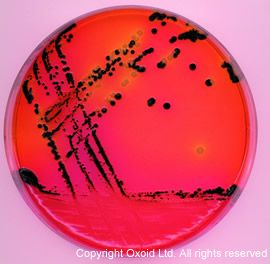Specifications
|
Typical Formula* |
gm/litre |
|
Yeast extract |
3.0 |
|
L-Lysine HCl |
5.0 |
|
Xylose |
3.75 |
|
Lactose |
7.5 |
|
Sucrose |
7.5 |
|
Sodium desoxycholate |
1.0 |
|
Sodium chloride |
5.0 |
|
Sodium thiosulphate |
6.8 |
|
Ferric ammonium citrate |
0.8 |
|
Phenol red |
0.08 |
|
Agar |
12.5 |
|
pH 7.4 ± 0.2 @ 25°C |
Description
Xylose-Lysine-Desoxycholate Agar was originally formulated by Taylor1 for the isolation and identification of shigellae from stool specimens. It has since been found to be a satisfactory medium for the isolation and presumptive identification of both salmonellae and shigellae2. It relies on xylose fermentation, lysine decarboxylation and production of hydrogen sulphide for the primary differentiation of shigellae and salmonellae from non-pathogenic bacteria.
Rapid xylose fermentation is almost universal amongst enteric bacteria, except for members of the Shigella, Providencia and Edwardsiella genera1. Xylose is thus included in the medium so that Shigella spp. may be identified by a negative reaction.
Salmonella spp. are differentiated from non-pathogenic xylose fermenters by the incorporation of lysine in the medium. Salmonellae exhaust the xylose and decarboxylate the lysine, thus altering the pH to alkaline and mimicking the Shigella reaction. However, the presence of Salmonella and Edwardsiella spp. is differentiated from that of shigellae by a hydrogen sulphide indicator.
The high acid level produced by fermentation of lactose and sucrose, prevents lysine-positive coliforms from reverting the pH to an alkaline value, and non-pathogenic hydrogen sulphide producers do not decarboxylate lysine. The acid level also prevents blackening by these micro-organisms until after the 18-24 hour examination for pathogens.
Sodium desoxycholate is incorporated as an inhibitor in the medium. The concentration used allows for the inhibition of coliforms without decreasing the ability to support shigellae and salmonellae.
The recovery of Shigella spp. has previously been neglected despite the high incidence of shigellosis. This has been due to inadequate isolation media3. The sensitivity and selectivity of X.L.D. Agar exceeds that of the traditional plating media e.g. Eosin Methylene Blue, Salmonella-Shigella and Bismuth Sulphite agars, which tend to suppress the growth of shigellae. Many favourable comparisons between X.L.D. Agar and these other media have been recorded in the literature4,2,5,6,7,8,9,10.
The recovery of salmonellae and shigellae is not obscured by profuse growth of other species3 therefore X.L.D. Agar is ideal for the screening of samples containing mixed flora and suspected of harbouring enteric pathogens e.g. medical specimens or food products. Chadwick, Delisle and Byer11 recommended the use of this medium as a diagnostic aid in the identification of Enterobacteriaceae.
X.L.D. Agar, in conjunction with MLCB Agar, is specified for use following enrichment culture in Modified Semi-Solid Rappaport Medium (MSRV) when examining faeces for Salmonella spp12. It is also used for the isolation of Salmonella from food and animal feedstuffs (ISO 6579-1:2017 Microbiology of the food chain -- Horizontal method for the detection, enumeration and serotyping of Salmonella -- Part 1: Detection of Salmonella spp.)13.
X.L.D. Agar is tested in accordance with ISO 11133:201414. Quality certificates are available for every batch.
| Product Name | XLD Medium , 500 g |
|---|---|
| SKU | OXOCM0469B |
| Visibility | Catalog, Search |
| Brand | No brand |
| Lead time if no stock (days) | 56 |






The information below is required for social login
Sign In
Create New Account